As women, our bodies are intricate systems that sometimes exhibit discomfort to signal underlying issues. One such concern is the pain experienced under the left rib cage after eating.
While it can be disconcerting, understanding its causes, implications, and potential solutions can help us navigate this discomfort more effectively.
Anatomy of the Left Rib Cage and Abdominal Region
To unravel the mystery behind this pain, let’s start with a quick tour of our body’s architecture. The left rib cage shelters vital organs like the stomach, spleen, and colon. Nearby, the pancreas joins the scene.
Getting acquainted with these anatomical neighbors is essential in deciphering the pain’s origins.
Common Causes of Pain Under the Left Rib Cage After Eating

- Gastritis: Inflammation of the stomach lining, often provoked by factors like infection or overuse of certain medications.
- Peptic Ulcers: Open sores along the stomach or upper intestine lining that can trigger discomfort after meals.
- GERD (Gastroesophageal Reflux Disease): Stomach acid’s unwelcome visit to the esophagus, causing heartburn and left rib cage pain.
- Pancreatitis: Inflammation of the pancreas, arising from various causes including gallstones or excessive alcohol intake.
- Spleen-related Concerns: An enlarged spleen due to infections or blood disorders might be a source of left-sided discomfort.
- Splenic Flexure Syndrome: Trapped gas in the colon’s bend near the left rib cage can lead to pain after eating.
- Musculoskeletal Factors: Strained muscles or inflammation in the rib cage region, known as costochondritis, can mimic internal discomfort.
- IBS (Irritable Bowel Syndrome): A gastrointestinal disorder causing abdominal pain and changes in bowel habits, often triggered by certain foods.
- Food Intolerances: Consuming foods one is intolerant to, such as lactose or gluten, can cause left rib cage pain.
- Gas and Bloating: Regular digestion leads to gas production, which may result in bloating and discomfort.
- Hiatal Hernia: When a part of the stomach pushes through the diaphragm, it can cause left-sided discomfort post meals.
- Diverticulitis: Inflammation or infection of colon pouches may result in pain under the left rib cage.
Also Check Out: Wide Rib Cage in Females: 5 Tips to Solve This Issue
Connecting Digestion and Discomfort

Understanding the process of digestion is pivotal. As our bodies break down food, they might trigger reactions that manifest as pain. IBS, often influenced by diet, plays a significant role here. Its symptoms, including left rib cage pain, underline the complex interaction between food and our system.
Check Also: How To Reduce Lower Belly (Fupa) Fat Through Home Workouts
Symptoms and Diagnostic Pathway
Describing the pain – sharp, dull, cramping – helps professionals decipher the underlying cause. If the discomfort persists or worsens, consulting a healthcare provider is vital. Diagnostic methods like medical history reviews, physical exams, imaging, and endoscopy contribute to accurate identification.
Dealing with Discomfort: Treatment and Prevention
Managing the pain under the left rib cage involves lifestyle adjustments like mindful eating and portion control. Medications such as antacids and pain relievers might offer relief, but treating the underlying condition is essential. Preventing recurrence entails a balanced diet, regular exercise, and maintaining a dialogue with your healthcare provider.
Also Read: Top 17 Wide Rib Cage Models With Unique Beauty Of Natural Proportions
Seeking Professional Guidance
Certain symptoms, like severe pain or sudden changes, demand swift medical attention. It’s crucial to heed these signs and prioritize your well-being.
Conclusion
Understanding the causes, symptoms, and management of pain under the left rib cage after eating empowers you to make informed health decisions. Remember, seeking professional advice and embracing a health-conscious lifestyle are your best allies in maintaining overall wellness.



